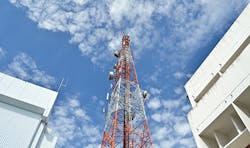The demand for real-time data and information (streaming) has never been greater for both personal and enterprise users. Fast and reliable access to information is no longer a luxury, it is expected — and the implications on business never more critical.
But there is a problem that keeps getting worse. Anytime-Anywhere access to information has created a traffic jam of sorts as the number of devices accessing our wireless networks has increased exponentially over the last 10 years — with no sign of letting up. This means the roads our devices use to access the information is congested. Some would say to nearly the point of complete gridlock in many areas. Fast and reliable network coverage is critical for user satisfaction — never mind critical healthcare networks and other urgent first-responder type communications.
There remains a need for ongoing wireless infrastructure upgrades and advancements. Both Wi-Fi and in-building Distributed Antenna Systems (DAS) support the advancements required for wireless bandwidth optimization. With 70% to 80% of mobile broadband service traffic generated indoors, DAS is a commonly adopted solution that improves network coverage and Key Performance Indicators (KPIs). DAS is an ideal solution for supplying high capacity and widespread coverage when traditional network facilities are strained, and for when coverage demands are fairly constant and predictable.
Large macro cells with limited backhaul capacity, and less and slower data, means less complex routers for edge and service applications.
The question today is: how does the future of network architecture, driven by wireless data demand, impact the use of Wi-Fi and DAS?
Wireless Networking Evolution
We’ve gone from a macro cell network to a network with macro cells at the base, and small cells and DAS providing selective access density. The evolution indeed creates changes beyond the implementation of base stations and remote radios.
Large macro cells with limited backhaul capacity, and less and slower data, means less complex routers for edge and service applications. As data and speed quantity increases, and the large macro cells converted into a higher quantity of smaller networks, the edge routers need more scalability and power, creating a demand for a powerful aggregation service router. In the wide-scale heterogeneous network (HetNet), fiber is necessary to support the data speed and quantity in the backhaul.
A recent Researchmoz (http://www.researchmoz.us/) market report, "The HetNet Ecosystem (Small Cells, Carrier Wi-Fi, C-RAN & DAS): 2016 – 2030 – Opportunities, Challenges, Strategies & Forecasts," predicts that small cell, carrier Wi-Fi, C-RAN and DAS investments will account for nearly $13 billion by the end of 2016. The market is further expected to grow at a CAGR of 15% between 2016 and 2020, as mobile operators remain committed to tackle the continued growth of mobile data traffic and evolving coverage requirements.*
Power Distribution and the Importance of Planning
Today we see the continued development of how small routers have evolved to large ones. We’ve seen the same thing in aggregation service routers to support video, data, and voice applications. This creates more power demand as the quantities of routers increase in the new networks. What’s more, the power demand per router increases as the sizes increase.
From a power distribution perspective, the requirements are changing and demand more power, more distribution, and in more compact designs. So although power distribution can support all the absolute power needs of today’s denser networks, without design improvements and updates it is not being supported in the most efficient way.
As wireless networks advance, it is exceptionally important to invest in power distribution. Key improvements in power distribution that are needed include:
• Front access to deal with limited space and limited access to the rear of panels.
• Higher capacity inputs to address increased power demands and limited space, allowing for more power in the same rack unit of space.
• Best-in-class circuit breaker panels designed for both in-building and harsh outside plant environments. One such product has been recently designed by Westell.
DAS’ Important Role in Network Infrastructure
There needs to be a systematic understanding of Wi-Fi, DAS, and small cell technologies. And from a cost, functionality, and aesthetic perspective, the earlier the planning at the network, metro, venue, campus and building level, the better the infrastructure solution will be.
Fiber, coax, and GigE cable installation plans also need to be put in place as early as possible. It is critical to ensure that AC power capacity is available in the right areas, and that there is room for the DC power systems and any resulting DC power distribution. Typically, the areas to consider for power are at the intermediate distribution frame (IDF), and at the telecommunication demarcation point (access point where the customer’s internal network meets the service provider’s external network). Generally, these areas are allocated to a small area, a "closet". And proper planning for temperature/environmental control also needs to be considered.
Fiber will definitely be driven deeper into the network. Because of so much success with fiber hybrids, fiber infrastructure can be relegated to backhaul transport of high-quantity and high-speed data, and the connection from the physical layer/fiber to the user can be handled by coax or GigE.
While it’s inevitable that all manners of base stations will be used in future network deployments, DAS will continue to play a crucial role in providing on-demand capacity at all times: whenever and wherever needed.
Building out complementary DAS and Wi-Fi networks provides fail-safe capabilities at times of peak usage. The two are symbiotic partners: when the Wi-Fi network is strained, the DAS network relieves it.
Endnotes
*For more information, please visit http://www.marketwatch.com/story/the-hetnet-ecosystem-to-grow-at-a-cagr-of-15-over-2016-2030—global-market-investments-in-small-cells-carrier-wi-fi-c-ran-das-opportunities-challenges-and-forecast-2016-07-13-102031555.
To learn more about the Research Report, published February 2016, with ToC and Free Analysis, please visit http://www.researchmoz.us/the-hetnet-ecosystem-small-cells-carrier-wifi-cran-das-2016-2030-opportunities-challenges-strategies-forecasts-report.html.






